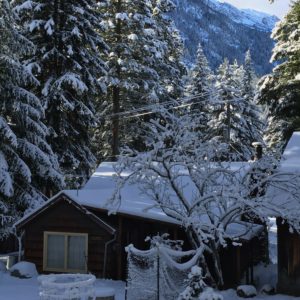Once More To the Lake
“Once More To the lake,” is the title of one of E. B. White’s loveliest essays. It recounts the story of White taking his son to a lake where his father had once taken him. Together they did what he and his father had done a generation earlier. They fished, swam and and poked around the lake in a canoe.
“Once More To the Lake” evokes the timelessness quality of such summer haunts.
 This week Linda and I made the trip, once more to the Lake. In this case Wallowa Lake, where our family cabin has stood (at least the initial part of it has stood) since 1926. Since our cabin is not winterized it stands empty from at least October through May. (The picture at right shows the cabin in winter a couple years ago when I came to cut Christmas trees.)
This week Linda and I made the trip, once more to the Lake. In this case Wallowa Lake, where our family cabin has stood (at least the initial part of it has stood) since 1926. Since our cabin is not winterized it stands empty from at least October through May. (The picture at right shows the cabin in winter a couple years ago when I came to cut Christmas trees.)
The first trip is always to “open the cabin.” Turn on the power, get the water running, clear away the debris of winter, and clean house. I check on the ten or so trees I’ve planted in recent years to see how they’ve wintered, plus a nearby grove of volunteer white fir and spruce that I tend. I note what appear to be the slash marks made by a bear on one older tree, and the intricate coral-like fungi growing from the stump of a fir we took down ten years ago.
There is a timeless quality to this place. We come up the hill from the small town of Joseph, Oregon. As we crest the hill, the five mile length of the Lake is suddenly there, set in a bowl of terminal moraines, flanked at the south end by the three mountains, Howard, Bonneville and Joseph.
The timelessness is both reality and illusion. The ancient mountains, the bend of road, the forests of fir, pine and hemlock, the moraine decked out in its bright spring bloom of yellow Balsam Root flowers, stay much the same. And we want that. We want something that doesn’t change. I’m not sure that longing is realistic, but it is real and deep.
So our eyes are always keen, on the opening up trip. for what has changed. Two caught our eye right away. The State is building a bike trail from Joseph to the foot of the Lake, a distance of about a half-mile.
Years ago when our son Nick was about the age his son, Levi, is now, Nick and his grandfather were biking along that stretch of road when Nick was hit by an RV. He wasn’t hurt. The RV just kind of pushed him off the roadside. But his grandfather was terrified. The contrite RV driver loaded them both, and their bikes, aboard and brought them back to the cabin.
The other change is a shock of new electrical cables, running along the Lake road and up into the cabin and amusements area at the head of the Lake. One of the pivotal power poles is located right in front of our cabin. So we have a bevy of new cable and spacers, plus additional guy wires from the pole to the ground. Five hundred yards away the new gaggle of wires crosses the road not once but twice.
I grew quite grumpy about this assault of wire and cable, this incursion into my timelessnes, or illusion of it. Finally, Linda said, “You’re getting yourself all worked up about something you can’t do a thing about.” “Just look at all those wires, will you?” I protested. “I chose not to,” she replied. We lifted our eyes unto the hills.
It isn’t Seattle where you come to some intersection you haven’t passed through in two months and find it so different you’re not sure you’re in the same place. Here the changes tend to nibble at the edges of that sense of timelessness.
In recent years the State of Oregon has been promoting this area as one of the “Seven Wonders” of Oregon. This spring I even saw a big ad on the side of a bus in Seatle touting the wonder of the Wallowas.
I go zenophobe. “Close the borders,” “draw up the bridges.” “ ‘They’ will ruin it.”
With time, we adjust. Make our peace. We do what we can through organizations like the Wallowa Land Trust and Nature Conservancy to preserve the character of the area amid change.
But in the end, the really timeless thing is the ebb and flow of continuity and change.
![Anthony B. Robinson [logo]](https://www.anthonybrobinson.com/wp-content/themes/anthonybrobinson/images/logo.png)
![Anthony B. Robinson [logo]](https://www.anthonybrobinson.com/wp-content/themes/anthonybrobinson/images/logo-print.png)